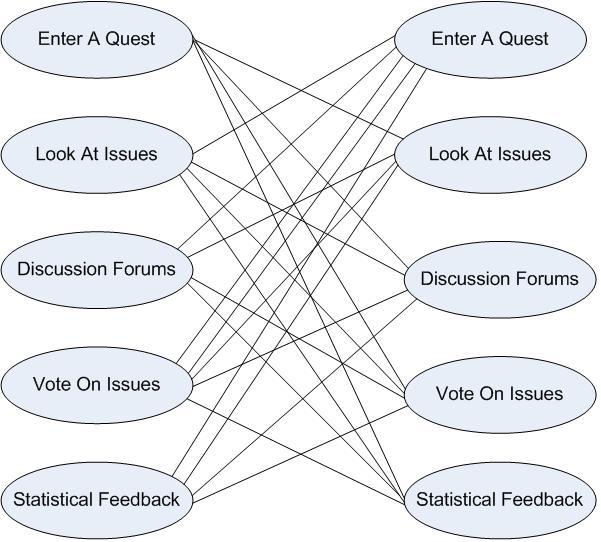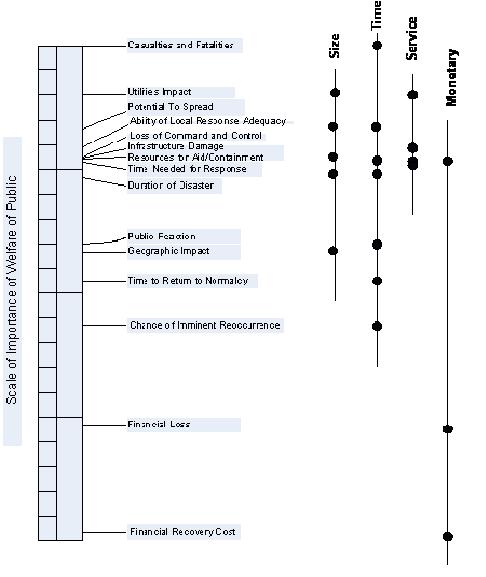| Version 17 (modified by , 16 years ago) ( diff ) |
|---|
Dynamic Delphi Decision Making
A module to improve the ability to make decisions in complex scenarios. This module considers a problem and helps a group discuss and rank a group of alternatives into a ranked list which provides information on the items in respect to one another (how much more one is desired over the other) and also considers uncertainty by showing the users how the items in the list are affected.
Summary
Increasingly, extreme events demand large groups of experts distributed in both location and time to communicate, plan, and coordinate actions. When responding to extreme events, very often there are both alternative actions that might be considered and far more requests for actions than can be executed immediately. The relative desirability of each option for action could be a collaborative expression of a significant number of emergency managers and experts trying to manage the most desirable alternatives at any given time, in real time. This same decision process could be used for a number of tasks but will be designed for distributed dynamic decision making during time critical phases of extreme events. This is because our proposed system is specially designed to save time, remove ambiguities, and decrease uncertainty, major challenges described in the literature on time critical decision making during the volatile time critical phases of emergency.
User Stories
1.Propose a new option to consider
2.Comment on any option proposed
3.Vote on a relative comparison of any two options
4.View the votes to find both disagreements and agreements
5.Change their votes based upon discussion feedback and new options
6.View a linear interval scale for the options based upon current votes
7.View a modified interval scale based upon the missing votes for any options showing the degree of uncertainty in the relative position of an item in the scale resulting from those that have already voted.
- Calculation for vote/revote (their first initial vote is kept, present vote, then a new vote (which is compared to the present vote and updated))
- Each item is voted upon with paired comparisons which produces a frequency count which is turned into a percentage number which is matched up with the corresponding number on a Unit Normal Table which finally produces a rank.
- A calculation for uncertainty is done: everyone who can vote - those who did
So there are three scales:
- one from the calculation from Thurstone (of which code is available for the unit normal conversion table)which takes many individual votes and calculates one group opinion.
- one with this, but including uncertainty (those who didn't vote) showing the best case outcome (if all votes go in favor of that item).
- and then the third shows the opposing side (uncertainty) where the items will stand on a vote given they receive no more votes.
Implementation
I think the major part is a lot of nested arrays to represent the matricies.
User Interface
Design
The following diagram shows how it's important for functionalities to be available with as few 'clicks' as possible. this saves time and gets experts to the information they need as quickly as possible. This shows the 5 primary functionalities required of the system

The Primary Interface Design mimics that of Web2Py - this design can be better seen on the original Research Proposal. link provided under 'background documentation below. Figure 10.6 Screenshot of Integrated Functionality.
-/(+) means that each list below can be expanded or contracted.
This layout corresponds with the design above.
THE DECISION MAKING MODULE USER INTERFACE
[Lists | Voting | Discussion | Scales ]
Lists
A user creates the problem representation, create lists
-/(+)[ GroupName ]
- ListName1 [ discussion | vote |scale] created by UserName
- ListName2 [ discussion | vote |scale] created by UserName
- ListName3 [ discussion | vote |scale] created by UserName
- …
(function to) create list with listname:
Voting
Where votes can be made, changed or put on hold
-/(+)[votingList ]
- voteList1 [ vote | change vote | select items ] creates new expert Scale, group Scale, Uncertainty
- voteList2 [ vote | change vote | select items ] creates new expert Scale, group Scale, Uncertainty
- voteList3 [ vote | change vote | select items ] creates new expert Scale, group Scale, Uncertainty
- …
Discussion
Forums for corresponding List where experts can post reply and/or agree or disagree with a prior post
- forumDiscussion1.html [ post new | view]
- …
Scales
Scales offered to experts
- scaleList1.html [ pindividual | group | uncertainty | side by side]
- scaleList2.html [ pindividual | group | uncertainty | side by side]
- …
This next screen shows how paired comparisons can be presented to the user. This can be checkboxes or just something that indicates that one of the pairs has been selected over the other.
The Decision Making System Welcome BigFoot (logout)
ÛBack <button>
Item ID57
Gasoline Resource Allocation
Description: There are 30,000 gallons on reserve. This is all of the supply for the next 30 hours. There are many groups in need of this fuel. How should this be allocated?
Criteria: Which group needs the gasoline the most?
Please select one item from each pair that you consider needs gasoline more than the other.
o Hospital, o Reserve
o Hospital, o National Guard
o Emergency management personnel, o National Guard
o National guard, o Reserve
o Reserve, o Emergency Management Personnel
o Emergency Management Personnel, o Hospital
[SUBMIT]
Scales Visualized for Feedback
This is the way I'd like to see the scales for feedback (3) - This is how Thurstone presented them. However, the lines drawn out to the right which bring out other dimensions is NOT required. This is just to demonstrate that other dimensions can be brought out from the results which could provide further insight. This is for a human to do though.
Background Reading
A Dynamic Delphi Process Utilizing a Modified Thurstone Scaling Method: Collaborative Judgment in Emergency Response
*http://citeseerx.ist.psu.edu/viewdoc/summary?doi=10.1.1.107.1633
The Formal Research Proposal
*http://sites.google.com/site/conniemwhite/Home/research-proposal
Need to request access:
Attachments (10)
- CollExpJud.pdf (169.5 KB ) - added by 16 years ago.
- ThurstoneScale.png (94.5 KB ) - added by 16 years ago.
- ThurstoneScale.2.jpg (32.3 KB ) - added by 16 years ago.
- ThurstoneScale.jpg (32.3 KB ) - added by 16 years ago.
- dm5.jpg (32.0 KB ) - added by 16 years ago.
- dm6.jpg (46.9 KB ) - added by 16 years ago.
- dm3.jpg (57.0 KB ) - added by 16 years ago.
- ItemSelectionUI.jpg (48.6 KB ) - added by 16 years ago.
- homeUI.jpg (149.2 KB ) - added by 16 years ago.
- pairCompUI.jpg (98.6 KB ) - added by 16 years ago.
Download all attachments as: .zip


